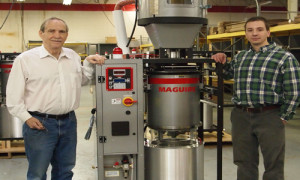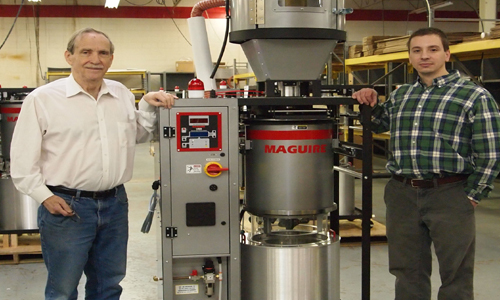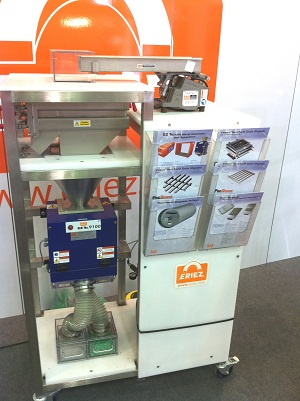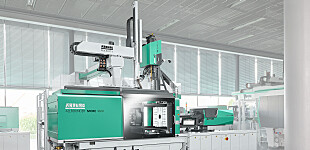Outstanding Precision of Load Cells Makes Possible Level Control within +/- 0.5%
ASTON, PA, U.S.A., February 26, 2015: Maguire Products, Inc. has incorporated load cell technology into its patented VBD™ vacuum resin dryer, increasing its accuracy and reliability and providing plastics processors with new capabilities for controlling and documenting their use of material, the company announced today. Maguire will be demonstrating the enhanced VBD dryer at NPE2015 (Booth W5663).

The VBD dryer now uses load cells for continuous control of the resin level in two of the three vessels in the system–the vacuum chamber and the retention hopper. The load cells operate on a loss-in-weight basis, providing real-time data on material throughput that is unaffected by variations in bulk density. They achieve accuracy of +/- 0.5%, according to Mike Gera, senior dryer product manager.
“The use of load cells in the vacuum and retention vessels provides 100% reliability and is superior to alternatives such as capacitive proximity sensors and paddle wheel sensors,” said Mr. Gera. “Because of their accuracy, they provide molders and extrusion processors with new tools for increasing the efficiency and versatility of their operations.”
Gera cited these capabilities made possible by the use of load cells:
● Enhanced control over material throughput. Load cells enable the microprocessor in the controller to monitor, display, and log throughput in real time. As the first batch of material is conveyed away from the dryer to the processing machine, a throughput rate is calculated. This rate is updated once per minute. Material usage documentation is available via USB port, making possible proactive monitoring of inventory. Load cells also enable the microprocessor to run a resettable flow totalizer, which is displayed on the screen and entered in the event log.
● Energy savings. Improved control over throughput rate makes it possible to set the rate to precisely match that of the process, enhancing energy efficiency and avoiding an excess of dried material left over at the end of a run.
● Option to run batches. While the VBD dryer provides a continuous flow to accommodate the throughput of a molding or extrusion process, load cells enable the dryer to run batches. For example, with Batch Mode selected in the controller, the operator is prompted to enter a batch size—for example 1,000 pounds (455 kg). The VBD will run 1,000 pounds and then automatically shut down. The shutdown is anticipated so that the vacuum chamber and retention hopper are empty, which is desirable at the completion of a batch run.
Load Cells Further Enhance the Efficiency of a System that Cuts Energy Use by 60%
The cost savings achieved with vacuum drying in comparison with standard desiccant dryers result from a reduction in energy consumption of more than 60%; elimination of the need to regenerate desiccant; and reduction in startup time as a result of a drying cycle that is only one-sixth as long. In addition, resin is exposed to elevated temperature for as much as 80% less time than with the desiccant dryer, which means less processed-in stress.
The VBD system eliminates most moving parts, using gravity to move material through vertically arranged stages of the drying process. It is typically a continuous batching operation carried out in three heavily insulated, stainless steel-lined vessels arranged vertically. High-speed slide-gate valves for dispensing material from one vessel to another have an accuracy per dispense of +/- 4 grams and are of the same design widely employed in other Maguire equipment. The system uses ambient air that is circulated by a blower whose variable-frequency drive saves energy.
From top to bottom the vessels are:
● Heating hopper. By means of a centrifugal blower and a 40 kW heating element, material is brought to a temperature that has been set on the control panel. The volume of this hopper is three times that of the next (vacuum) vessel, ensuring adequate heating time.
● Vacuum vessel. A vacuum applied by a venturi generator reduces the boiling point of water, causing moisture within the pellets to volatilize and be forced out of the pellet into the low-pressure environment surrounding it. The moisture is purged from the vessel with -40 dew point air constantly generated by a membrane air dryer.
● Retention / take-away hopper. The membrane air dryer also pressurizes the vessel and blankets the dry material ensuring that the target level of dryness is preserved until the material is discharged into the plastics extrusion or molding process.
Photo Caption: Shown with Maguire® VBD™ vacuum dryer are president and chief designer Steve Maguire (at left) and senior dryer product manager Mike Gera. Load cells are located beneath the vacuum vessel (middle vessel in photo) and the retention vessel (at bottom)
Website: www.maguire.com







